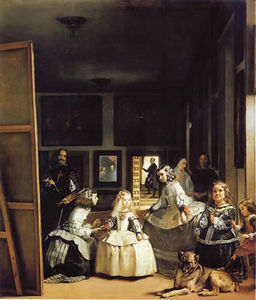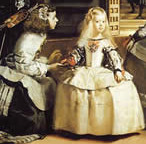Las Meninas Analysis
- Date of Creation:
- circa 1656
- Alternative Names:
- The Family of Felipe IV
- Height (cm):
- 318.00
- Length (cm):
- 276.00
- Medium:
- Oil
- Support:
- Canvas
- Subject:
- Scenery
- Art Movement:
- Baroque
- Created by:
- Current Location:
- Madrid, Spain
- Displayed at:
- Museo Nacional del Prado
- Owner:
- Museo Nacional del Prado
- Las Meninas Analysis Page's Content
- Introduction
- Composition
- Mood, Tone and Emotion
- Brushstroke
Introduction
Stylistically, Las Meninas is like the sum of the best parts of all of Velázquez's earlier paintings. Just like his early bodegones, the paintings is marked for its intense, Caravaggesque chiaroscuro, a limited and somber palette, a photo-like realism, and remarkably loose, free, unrestrained brushstrokes.
Las Meninas Composition
If Las Meninas was voted as the greatest painting of all time, it is largely due to the extraordinary and innovative complexity of the composition. Velázquez's painting may appear relatively simple and straightforward at first glance, but a closer inspection reveals that Las Meninas is a composition of striking intricacy.
Layers of depth:
The picture plan of Las Meninas is divided into a grid system, of quarters horizontally, and sevenths vertically. Furthermore, the canvas is divided into seven layers of depth, as well. Las Meninas has the deepest, most carefully defined space of any Velázquez painting, and is the only painting where the ceiling of the room is visible.
The space of the room is portrayed like a stage set, with the seven layers of space arranged at irregular intervals. The first, shallowest layer begins with the projecting canvas at the left of the picture plane, and encompasses the dwarf kicking the dog on the right side.
The second level consists of the Infanta and her maids, the third Velázquez, the chaperone and bodyguard, the fourth the rear wall of the room, the fifth the space beyond the open door and the figure of Nieto, the sixth the space of the mirror's reflection, and finally the seventh level is space that the mirror's reflection implies, namely the space outside of the picture plane where the King, Queen and viewer stand.
Patterns and connections:
For such a large, multi-figure composition, excellent organization is of the essence. Velázquez managed to instill order in Las Meninas by utilizing a system of curved and diagonal lines. He ordered the figures in the foreground along an X shape with the infant Margarita in the center, thus emphasizing her importance and making the five-year-old child the focal point of the composition.
One diagonal is created formed with the kneeling lady-in-waiting to the Infanta's left, a diagonal which extends to the standing lady-in-waiting on the right and finishes with the chaperone and body guard in the background. The other diagonal begins with Velázquez on the left, and descends through the Infanta's head to the reclining dog on the right.
Velázquez masterfully uses light and dark to further order the composition. With light and shadow, he creates a system of double arcs that further centralizes the Infanta, one above that starts with Velázquez, descends to the Infanta, and rises to Nieto in the background, and one below, created by the arc of light in the foreground.
The arrangement of the figures themselves creates a pattern that further orders the composition. From the left stands Velázquez, followed by the Queen and King in the mirror, followed by Nieto, followed by the female chaperone and the bodyguard. This creates a rhythm of man woman man, man woman man, all of these figures standing above the Infanta and thus symbolically protecting her. The fact that the Infanta is almost pure white further makes the small girl stand out, given that the majority of the painting is cast in tenebristic shadows.
Frames:
Velázquez's Las Meninas is a picture about frames and framing. All the figures are framed by the very room in which they are situated, while literal frames exist in the form of the canvas on the left, the frames of the paintings on the rear wall, the doorway that frames Nieto, and finally the mirror that frames the royal couple.
These last two frames are the most interesting, in terms of the compositional device that they provide. After the Infanta, these are the two other focal points of the painting, and they create a push me-pull you affect. To the right, the open door beckons the viewer to imagine the space beyond, while the mirror to the left, while giving the illusion of recessive space, actually pushes the viewer out of the picture plane, because it is reflecting the very space in which the viewer is situated.
Las Meninas Mood, Tone and Emotion
Velázquez and the King
Velázquez and Philip IV had an unusually close relationship. Contemporary reports suggest that Velázquez was perhaps one of Philip's only close friends and confidents. Legend has it that it was Philip IV himself who painted the red cross of the Order of Santiago on Velázquez's chest in Las Meninas after the artist past away, a death which came as a terrible blow to this lonely and rather pathetic monarch.
Unlike other court portrait painters, Velázquez avoids ostentation or unbelievable idealism when painting his royal subjects. Instead, he instilled his sitters with an unprecedented humanity, and delighted in rendering various surfaces and textures (hair, silk, glass, mirrors) with as much truth as possible.
In Las Meninas, the very composition has the stamp of realism upon it; the interrupted actions of the personages (the Infanta is in the middle of turning her head, the littlest dwarf on the right teasingly kicks the dog, who docilely grimaces) lends a snapshot-like atmosphere to the painting.
Las Meninas Brushstroke
From a distance, Las Meninas gives the impression of being remarkably realistic, and the composition itself is often described as "snapshot" like. Amazingly, however, Velázquez manages to create this realism out of the most unrestrained and abstract of brushwork.
From close up, it is almost impossible to distinguish shapes or contours: the picture surface becomes a dazzling display of dancing, shimmering daubs of paint, with hastily applied highlights to suggest reflected light. As the 17th century Spaniard Antonio Palomino stated, "One cannot understand it if standing too close, but from a distance, it is a miracle!"











